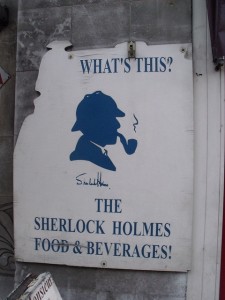 Benedict Cumberbatch won an Emmy Award last night for his portrayal of Sherlock Holmes in the BBC series Sherlock and Martin Freeman won an Emmy for portraying Dr. Watson in the same show.
Benedict Cumberbatch won an Emmy Award last night for his portrayal of Sherlock Holmes in the BBC series Sherlock and Martin Freeman won an Emmy for portraying Dr. Watson in the same show.
More movies, television series or books featuring the famous detective and doctor are likely to be made in the years to come as the Seventh Circuit decided last June that Sherlock Holmes and Doctor Watson, the famous characters created by Sir Arthur Conan Doyle, are no longer protected by copyright (Klinger v. Conan Doyle Estate, Ltd.,). I wrote about this case for the TTLF newsletter in July.
Sherlock Holmes and Dr. Watson first appeared in A Study in Scarlet, a story penned by Sir Arthur Conan Doyle which was published in 1887 and first released in the U.S. in 1890. This story is thus in the public domain in the U.S. because all work published before January 1st, 1923 are in the public domain in the U.S. However, Sir Arthur Conan Doyle published ten Sherlock Holmes stories, also after January 1st, 1923 and these then stories are still protected by copyright in the U.S.
The Estate of Conan Doyle (ECD) argued in front of the Seventh Circuit that if a “complex” character is protected by copyright, it is thus protected until the last work where the character appear falls into the public domain. The ECD further argued that “flat” characters don’t evolve, but “round” characters do. This argument failed to convince the Seventh Circuit, which decided that the two characters were no longer protected by copyright. The court added, however, that the original elements added in the later stories remained protected. The ECD then petitioned the Supreme Court to accept to review the case, but the Supreme Court denied certiorari (meaning it refused to review the case).
That decision was disappointed for many IP attorneys and scholars, as one of the questions asked to the Supreme Court in the petition was whether “a character that develops dynamically over time is entitled to copyright protection based on the last publication depicting the character’s evolution.” In essence, answering this question by the affirmative would have allowed authors to extend the protection of their characters indefinitely, as long as they would have continued to develop their characters “dynamically” (whatever that exactly means). Mickey would have finally married Minnie. Superman would have started a publishing empire. The Hulk would have created a line of face creams designed to cover greenness.
The art of developing a character is maybe best known by television writers, sometimes to the point of “shark-jumping.” Just imagine Sherlock Holmes in shorts (maybe tweed shorts?), on water skis, and smoking his pipe. Not a happy thought.
The image is Baker Street, London – What’s This? Sherlock Holmes – The Sherlock Holmes Food & Beverages! courtesy of Flickr user Elliott Brown under a CC BY 2.0 license.



